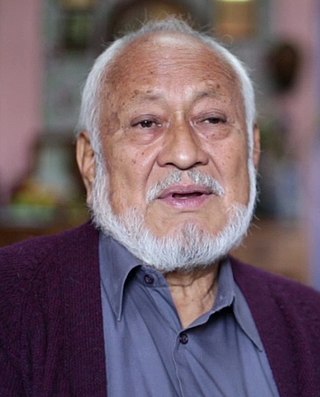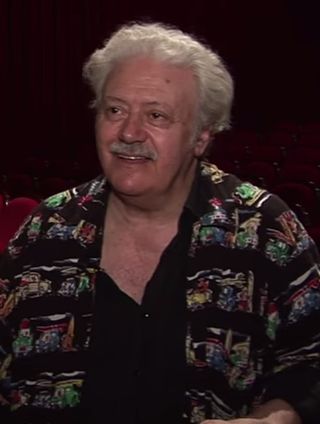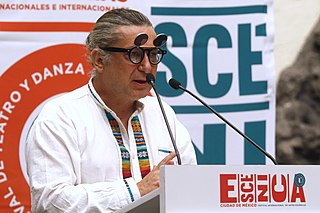
Sergio Vela (born June 27, 1964, in Mexico City) is a Mexican-American opera director, designer, radio and television host, musician, lawyer and academician.

Sergio Vela (born June 27, 1964, in Mexico City) is a Mexican-American opera director, designer, radio and television host, musician, lawyer and academician.
He studied piano with Héctor Rojas, singing with Maria Julius, orchestra conducting with Roswitha Heintze (1986) and Murry Sidlin at the Aspen School of Music (1988) and composition (1988–1992) with Humberto Hernández Medrano, a distinguished composer and a pupil of Carlos Chávez. He holds a magna cum laude law degree from the Escuela Libre de Derecho, where he studied from 1882 until 1987. At the same school he was tenure professor of legal history from 1989 until 2012. He also taught criminal law and Roman law at both the Escuela Libre de Derecho and the Universidad Anáhuac.
He made his doctoral studies at the National School of Music of the National Autonomous University of Mexico.
An accomplished polyglot, he is fluent in English, Spanish, French, Italian and German, and he reads, writes and translates other languages, such as Catalan and Portuguese.
His opera productions have been presented in the United States, Germany, Spain, Italy, Ireland, Brazil and Mexico. He made his debut at only 25 at the Palacio de Bellas Artes in 1990, with Faust , by Gounod. At the same venue he has directed La clemenza di Tito (1993), Idomeneo (1998) and Die Zauberflöte (2000) by Mozart, Der fliegende Holländer (1994), Tristan und Isolde (1996) and the first-ever Mexican production of the complete Der Ring des Nibelungen ( Das Rheingold , Die Walküre , Siegfried and Götterdämmerung ) (2003-2006) by Wagner, the world-premiere of The Visitors (1999) by Carlos Chávez, Macbeth (2001) by Verdi and the Mexican premiere of Die Frau ohne Schatten (2012) by Richard Strauss.
Among his European credits, he has directed and designed Turandot (1996) by Puccini at the Torre del Lago Puccini Festival, Mozart's Così fan tutte at the Mozart Festival in A Coruña (2002), the first modern production of Motezuma (2003) by Gian Francesco de Majo in Aschaffenburg, the first revival of María del Carmen (2003) by Granados at the Wexford Festival Opera, the first performance of the critical edition of La sonnambula (2004) by Bellini at the Teatro Massimo Bellini in Catania, Sicily and the world-premiere of the definitive version of Murmullos del páramo (2006) by Julio Estrada, performed at the Teatro Español (Madrid), the Theaterhaus Stuttgart, the Biennale di Venezia and at the Sala Nezahualcóyotl (Nezahualcóyotl Concert Hall) of the National Autonomous University of Mexico.
He made his American debut at the Virginia Opera in 1994 with Strauss's Salome . In 2013, on occasion of Wagner's bicentennial, he directed and designed Parsifal at the Amazon Theatre in Manaus.
Much attached to Juan Ibáñez (1938-2000), he adapted Ibáñez's Siempre es hoy and directed it in 2000 as a homage to the late director.
At the invitation of Ana Lara, he directed and designed El Cimarrón by Henze at Mexico City's Teatro Helénico in 2001.
His frequent collaborators in his opera productions are costume designer Violeta Rojas, choreographer Ruby Tagle, visual artist Ghiju Díaz de León, technician Iván Cervantes, executive producer Juliana Vanscoit and assistant directors Paulina Franch and Marielle Kahn.
In the past, he has also counted on the collaboration of many relevant designers, such as Alejandro Luna, Jorge Ballina, Philippe Amand, Tolita Figueroa, María Figueroa, Giusi Giustino, Donna Zakowska, Hugh Landwehr, Mónica Raya, Eloise Kazan, Cristiana Aureggi, Nikos Petropoulos and Víctor Zapatero, as well as assistant directors Hernán del Riego and Daniele De Plano choreographer and dancer Victoria Gutiérrez and actress Margarita Sanz.
Being trained on both musical and dramatic arts, his collaboration with conductors has been consistently deep and fruitful. Among those who have conducted his productions are Antoni Ros-Marbà, Luiz Fernando Malheiro, Guido Maria Guida, Marko Letonja, Antonio Florio, Max Bragado-Darman, Carlos Miguel Prieto, Stefano Ranzani, Rico Saccani, José Areán John DeMain, Enrique Diemecke and Peter Mark.
Among the singers that have taken part in his productions are Ramón Vargas, Francisco Araiza, Kolos Kováts, Ghena Dimitrova, Katia Ricciarelli, Paata Burchuladze, Rolando Villazón, Jon Frederic West, Luana DeVol, Greer Grimsley, Janice Baird, Richard Paul Fink, and many others.
From 1989 until 1992 he was artistic manager and director of the Bellas Artes Opera; from 1992 to 2000 he was director general of the Festival Internacional Cervantino; he was also coordinator of the 2000 Cultural Program: From the 20th Century to the Third Millennium and from 2001 until 2006 he was general music director of the National Autonomous University of Mexico. He was the president of the National Council for Culture and the Arts (CONACULTA) during beginning of the presidency of Felipe Calderón, from 2006 until 2009.
During his tenure at the National Council for Culture and the Arts, at his initiative, an inclusive cultural policy implying the systematic and fruitful collaboration between the private and public sectors was firmly rooted; a much-praised and comprehensive National Culture Program was presented; the artists supported by the Fondo Nacional para la Cultura y las Artes (FONCA) received a substantial increase on the monthly allowances and grants; an unprecedented increase on the public cultural budget was achieved; a National Culture Conference with the egalitarian participation of the Federal Government, the Mexico City Government and each of the State Governments and special committee for deciding the Federal financial support for cultural initiatives with full transparency were formally established; an annual minimum of Federal financial resources was decided for guaranteeing the strength of each of the States in cultural matters; the first Ibero-American Film Congress was held in Mexico and it was opened by President Felipe Calderón and Felipe, Prince of Asturias; the technical renewal of the Palacio de Bellas Artes was conceived; a deep updating of Mexico's international cultural relations took place; remarkable exhibitions of Mexican art and on the History of Mexico were presented at top museums in Paris, London, Madrid, Berlin, Zürich, Los Angeles, Chicago, Washington, Buenos Aires, Santiago and Tokyo, among other cities; the Carlos Chávez Youth Orchestra was completely renewed; the Paris [Salon du livre] was dedicated to Mexico in 2009 and a Mexican Year in France was decreed for 2010; a much-expected Ley del libro (Book Law) was promulgated; an ambitious program for updating the historical theatrical venues and other cultural infrastructure was started; a new and consistent National Theatre Company (Compañía Nacional de Teatro de México) was founded; a sound collaboration between the National Council for Culture and the Arts and the Cultural Commissions of the Senate of the Republic and of the Chamber of Deputies proved to be especially fruitful, and a Constitutional amendment for protecting and promoting the culture and the arts was agreed, with the support of all the political parties.
He is senior artistic advisor to the Orquesta Sinfónica de Minería and is artistic director of the Festival de México en el Centro Histórico and of the Festival de Música de Morelia. He is founder and curator of a free on-line musical quarterly, Quodlibet. He is consultant for several cultural institutions
He has lectured extensively on opera, music, the arts and the humanities, at several academic institutions and cultural organizations, such as the National Autonomous University of Mexico, the Instituto Tecnológico Autónomo de México (ITAM), the Universidad Iberoamericana, the Centro Nacional de las Artes, the Instituto Nacional de Bellas Artes, the Universidad Panamericana, the Fundación Miguel Alemán, the Asociación Filarmónica Mozart, the ProÓpera group, the Centro de Estudios Casa Lamm, among others. At the Auditorio Nacional, he gives regular introductory lectures to the HD Broadcasts of the Metropolitan Opera House.
For many years, he has hosted a weekly radio broadcast on opera, La ópera en el tiempo, every Sunday at 5:00 pm (CST), on Opus 94.5 of the Instituto Mexicano de la Radio (IMER). He is also host of the Saturday broadcasts of the Metropolitan Opera International Radio Network.
He has collaborated with TV UNAM and Once TV, and for 12 years (1994 and 2006) he hosted the weekly international opera broadcasts of Canal 22.
He has written and published a large amount of essays on art and the humanities, as well as poetic prose in several languages. A non-exhaustive list of such writings include:
Born to a cultivated family with roots in northern Mexico, southern Spain and the United States, his late father was the distinguished lawyer and academician Sergio Vela Treviño (1930-1993), and his mother is American-born Elena Vela Treviño, who studied at the Art Institute of Chicago and is acknowledged as a songwriter with the name of Nina Mares.
In 1991 he married Spanish-Mexican lawyer Marta Fuentes, and they have two daughters: Isolda María (born 1996) and Julia María (born 1999). Since her childhood, Isolda has taken part in several of her father's productions.
The couple divorced in 2005. Between 2008 and 2014 he was married haute cuisine chef Martha Ortiz.

The Palacio de Bellas Artes is a prominent cultural center in Mexico City. This hosts performing arts events, literature events and plastic arts galleries and exhibitions. "Bellas Artes" for short, has been called the "art cathedral of Mexico", and is located on the western side of the historic center of Mexico City which is close to the Alameda Central park.

José Pablo Moncayo García was a Mexican pianist, percussionist, music teacher, composer and conductor. "As composer, José Pablo Moncayo represents one of the most important legacies of the Mexican nationalism in art music, after Silvestre Revueltas and Carlos Chávez." He produced some of the masterworks that best symbolize the essence of the national aspirations and contradictions of Mexico in the 20th century.

Juan Soriano was a Mexican artist known for his paintings, sculptures and theater work. He was a child prodigy whose career began early as did his fame with various writers authoring works about him. He exhibited in the United States and Europe as well as major venues in Mexico such as the Museo de Arte Moderno and the Palacio de Bellas Artes. His monumental sculptures can be found in various parts of Mexico and in Europe as well. Recognitions of his work include Mexico's National Art Prize, the Chevalier des Arts et Lettres and membership in France's Legion of Honour.
Margo Glantz Shapiro is a Mexican writer, essayist, critic and academic. She has been a member of the Academia Mexicana de la Lengua since 1995. She is a recipient of the FIL Award.

The National Symphony Orchestra is the most important symphony orchestra in Mexico. With its origins traced back as 1881, along with the Boston Symphony Orchestra, it is the second-oldest symphony orchestra in the American continent. The orchestra does not have a permanent venue but performs regularly in the Grand Hall of the Palace of Fine Arts in Mexico City.

José Chávez Morado was a Mexican artist who was associated with the Mexican muralism movement of the 20th century. His generation followed that of Diego Rivera, José Clemente Orozco and David Alfaro Siqueiros. Although Chávez Morado took classes in California and Mexico, he is considered to be mostly self-taught. He experimented with various materials, and was an early user of Italian mosaic in monumental works. His major works include murals at the Ciudad Universitaria, Secretaría de Comunicaciones y Transportes and Museo Nacional de Antropología in Mexico City as well as frescos at the Alhóndiga de Granaditas, which took twelve years to paint. From the 1940s on, he also worked as a cultural promoter, establishing a number of cultural institutions especially in his home state of Guanajuato including the Museo de Arte Olga Costa - José Chávez Morado, named after himself and his wife, artist Olga Costa.
Maria Vilalta i Soteras was a Catalan-born Mexican playwright and a theatre director. Her plays have been translated, published and produced in numerous countries. She won the critic’s prize for the best play of the year ten times. In November 2010 she was awarded the National Prize for Arts and Sciences in the field of Linguistics and Literature, for her work which has national and international resonance. President Felipe Calderón Hinojosa gave her the award at Mexico's National Palace.

The Visitors is an opera in three acts and a prologue composed by Carlos Chávez to an English-language libretto by the American poet Chester Kallman. The work was Chávez's only opera. Its first version, with the title Panfilo and Lauretta, premiered in New York City in 1957. The final version with the title The Visitors was premiered in Guanajuato City, Mexico, in 1999, twenty years after the composer's death. The story is set in 14th century Tuscany during the time of the Black Death. The libretto uses the device of a play within a play to reflect and intensify the relationships between the protagonists, who in this case are loosely based on characters in The Decameron.
The history of opera in Latin America dates back to at least the early 18th century. Newspaper articles suggest that, around the time that Italian opera was introduced to Latin America, it was received with some disdain due to the language barrier. However, translations in the librettos of certain operas suggest that there was greater interest from Latin Americans than the news had credited. Opera arrived in Latin America as a consequence of European colonization. On October 19, 1701, La púrpura de la rosa premiered in Lima in the Viceroyalty of Peru, the first opera known to be composed and performed in the Americas. It is an opera in one act by Spanish composer Tomás de Torrejón y Velasco with a libretto by Pedro Calderón de la Barca, and is the only surviving opera by Torrejón y Velasco. It tells the myth of the love of Venus and Adonis, which provoked Mars's jealousy and his desire for vengeance. Although the libretto follows the Greek myth, the tragic love story is seen as a resemblance of the alliance that was formed from a political marriage between the Spanish and French monarchies. Opera performances were performed also in the country of Mexico. It is within that nation that the first indigenous opera composers of Latin America emerged, with Manuel de Zumaya being considered the first and most important early opera composer. Outside of Perú and Mexico, opera was slower to gain a foothold, and it wasn't until the early to mid-19th century that other nations in Latin America began producing their own opera composers. Many of these 19th-century operas focus on the historical conflict between Europeans and indigenous peoples and were influenced by zarzuela, a form of Spanish opera. Mexican zarzuelas, as well as revistas, soon arose from Spanish influence and gained popularity.

Sabina Berman Goldberg is a Mexican writer and journalist. Her work deals mainly with issues related to diversity and its obstacles. She is a four-time winner of the National Playwriting Award in Mexico and has twice won the National Journalism Award. Her plays have been staged in Canada, North America, Latin America, and Europe. Her novel, Me has been translated into 11 languages and published in over 33 countries, including Spain, France, the United States, England, and Israel.
Armonicus Cuatro is a group of four vocalists from Mexico: Mario Iván Martínez, Lourdes Ambriz, Nurani Huet and Martín Luna which mostly specializes in European medieval, Renaissance and Baroque music. All four are established musicians in their own right, with Martínez also known as an actor in film and Mexican television. The group has performed widely in Mexico at music and cultural festivals such as the Festival Internacional Cervantino as well as in Europe.

Abel Ramírez Águilar was a Mexican sculptor who won many prizes not only for traditional pieces in wood, stone and metal, but also for ice and snow sculptures in the United States, Canada, Japan and Europe. He was trained as a sculptor in Mexico and the Netherlands and has exhibited his work individually and collectively since the 1960s. He discovered snow and ice sculpting while visiting Quebec in the 1980s, first experiencing snow in his forties. The challenge intrigued him and he began sculpting this medium as an amateur. He began sculpting ice and snow professionally when he was entered in the competition associated with the 1992 Winter Olympic Games without his knowledge. Having practiced beforehand at an ice factory in Mexico City, he won the gold medal for this event, leading to invitations to other competitions for over twenty years. Ramírez lived in Mexico City.
Marcela Yolanda Del Río y Reyes is an intellectual, professor, journalist, diplomat and writer. Her works cover national and global issues.

Mario Gas Cabré is a Spanish actor and director. and winner of a Goya Award.

Jaime Chabaud is a Mexican playwright, screenwriter, teacher and researcher, who has written more than 130 plays over his career but is popularly known for his television work. His creative work has been translated into multiple languages and has received numerous awards including the 2013 Juan Ruiz de Alarcón Drama Prize, the 2010 World Theater Prize from the University of Buenos Aires and 2006 Víctor Hugo Rascón Banda National Drama Prize. Chabaud is also the founder and director of the Paso de gato theater magazine.
Tarsicio Herrera Zapién is a Mexican writer, researcher and academic, specializing in the culture and classical literature. He studies the works of Sister Juana Inés de la Cruz, as well as music composition and recovery of classical musicological works.

Esther Seligson was a Mexican writer, poet, translator, and historian. She was an academic, with a wide range of interests including art, cultural history, Jewish philosophy, mythology, religion and theater. She published books, poems, short stories and translations. She won the Xavier Villaurrutia Prize and the Magda Donato Award for her literary contributions.

José Solé was a Mexican theater director, stage actor, and set designer whose career extended over six decades. His interest in theater began during childhood in a small community then outside of Mexico City proper. Although he acted some small parts in movies, his theater career began while doing formal theater training, first in Mexico then in France. He worked to promote theater in Mexico, which did not experience the kind of governmental support that the other arts did after the Mexican Revolution, performing in and directing a wide variety of plays, as well as directing theaters and even the theatrical division of the Instituto Nacional de Bellas Artes. He received recognition for both acting and directing early in his career, but major awards such as Premio Nacional de Ciencias y Artes in the 2000s.

Ida Rodríguez Prampolini was a Mexican academic, art historian and cultural preservationist, who was heavily involved in the creation of organizations and institutions to preserve the artistic traditions of Mexico. To that end, she founded two art schools, eleven museums, twelve municipal archives, and over fifty houses of culture. She published over 400 articles and critiques of Mexican art and was honored with numerous awards over the course of her career. She was a member of the Mexican Academy of Arts, Mexican Academy of History and the Belgian International Union of Academies as well as a recipient of the National University Prize, which recognizes excellence in teaching and academic research, in 1991. In 2001, she was honored with the National Prize for Arts and Sciences in the category of History, Social Sciences and Philosophy and in 2002, she was awarded the Calasanz Medal from the Universidad Cristóbal Colón.